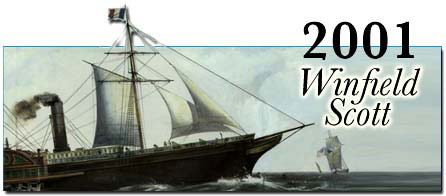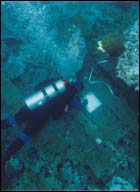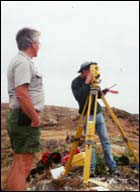
The wreck of the 1850s California Gold Rush steamship Winfield Scott, off middle Anacapa Island in the Channel Islands National Marine Sanctuary, was the focus of a phase II archaeological survey by maritime archaeologists from East Carolina University's Program in Maritime Studies during the summer of 2001. Under the direction of then graduate student Deborah Marx, the team focused on the documentation of engine and hull remains. Greenville, North Carolina is the home of the Maritime Studies Program, which teaches maritime history and underwater archaeology. The program emphasizes a hands-on approach to learning and gives graduate students the opportunity to gain valuable field experience in diverse conditions on a vast array of sites from North Carolina to Bermuda.
 |
| Archaeologist documents the fragile wooden hull remains of the steamship Winfield Scott. (Photo: Tane Casserley, NOAA MHP.) |
|
|
Built in New York City in March 1850, the Winfield Scott remained on the East Coast until January 1852, when it rounded Cape Horn and began its career on the Panama Route. The steamer provided gold seekers with regular transportation between San Francisco and Panama City before its sinking on 2 December 1853. Salvage removed many valuable components including portions of the hull and side-lever engines. After the National Park Service (NPS) located and identified the site in 1981, it went through extensive historical and archaeological examination culminating with the wreck being listed on the National Register of Historic Places. Constant monitoring by the NPS and NOAA ensures that the wreck site will not undergo further deterioration from sport diver collection activities.
The seven-day project during July 2000 concentrated on four objectives. Positioning the wreck site on a USGS topographic map of Anacapa Island was the first objective. The NPS and NOAA will include the positioning information into their Geographic Information System (GIS) database for further study on the distribution of Channel Islands shipwrecks. The survey's second objective focused on detailed documentation of the 10-foot by 14-foot section of the Winfield Scott's bottom hull structure and two side lever engines. Engine remains include the port paddle-wheel shaft, port paddle-wheel shaft support, port paddle-wheel bucket attachments, starboard cylinder base, starboard paddle-wheel flange, and starboard side lever. Special attention was paid to record damage done by salvage activities. Emphasis was placed on recording the condition and structural particulars of the Winfield Scott's fragile wooden hull. Area around the wood has been the subject of the greatest natural and man-made deterioration. Over the past ten years an entire layer of hull structure disappeared. The hull's rapid deterioration made it vital to record the irreplaceable details. Machinery and hull details revealed crucial information about a vanished type of marine steam engine and a style of ship construction that flourished because of the California Gold Rush.
 |
| Retired NPS archaeologist Don Morris lends a helping hand with the surveying of the wreck site from Anacapa Island. (Photo: Frank Cantelas, East Carolina University) |
|
|
Archaeologists located and identified previously undocumented features on the site for the third objective. Over the past ten years the site has been scoured away exposing wreckage previously obscured by sand and kelp. The project crew performed underwater and land searches near the beach to locate new features off the main wreck site and satisfy the fourth and final objective.
Cooperation between NPS, NOAA, and California State Lands Commission personnel was crucial in allowing East Carolina University archaeologists the chance to document the Winfield Scott's remains. Project results were combined with historical research to complete a master's thesis in the Maritime Studies Program. Information gathered for the thesis added to the fascinating history of the Winfield Scott and contribute to a greater understanding of Gold Rush steamships and the development of California.

Additional Resources and Links
Channel Islands National Marine Sanctuary
Program in Maritime Studies
|





